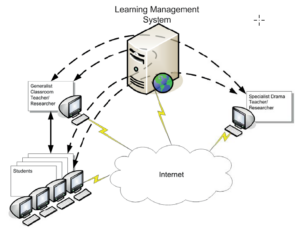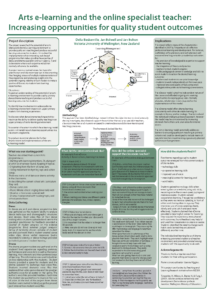Please view the poster for this project.
The poster layout is integral to the presentation of the research
Project description
The project researched the potential of an arts (dance and drama) e-learning environment to provide quality arts teaching and produce successful learning outcomes for students. It involved the implementation of an innovative, web-based programme that makes possible the expertise of dance and drama specialists online in years 6, 7, and 8 classrooms where such expertise would not normally otherwise be available.
A project team comprised researcher/specialist practitioners and classroom teachers in documenting the changing process of multiple implementations of the programme and producing insights into the potential ongoing viability of such models to make a positive difference to students’ arts learning opportunities.
Objectives:
To gain an understanding of the potential of an arts e-learning environment to provide quality primary dance/drama teaching and produce successful learning outcomes for students.
To identify how involvement in a dance/drama e-learning environment impacts on upper primary students’ arts learning experiences.
To discover what dance/drama teaching activities maximize the ability to deliver quality teaching in an upper primary school e-learning environment.
To ascertain the extent to which the e-learning model assists in timetabling arts learning opportunities in a classroom programme.
To produce recommendations for further development and implementations of the arts e-learning model.
What was our starting point?
Teachers described their current Arts programme as:
- Starting with learning intentions. Studying art or artist or other way round. Keeping it topical.
- Originating from the form of Jump Jam.
- Using movement in rhyming raps and action songs.
There was not a lot of dance or drama activitiy in the classrooms.
In describing the current school arts curriculum they said:
- Dance: Jump Jam
- Music: Whole school singing done really well
- Visual arts: Core areas covered well
- Drama: Incorporated with reading topic, and school productions
Data Gathering
Dance
In dance pre and post-dance programme data was gathered on the students’ ability to analyse dance technique and choreographic structures and devices. Short video files of their dance
making which students uploaded and sent to the specialist practitioner for feedback provided a ‘journal’ of student progress on the e-dance programme. Blind external judges’ analysis/
rating of randomly chosen samples of student pre and post work that is student created dance video clips, dance verbal responses to viewing of dance footage provided an holistic picture of student learning.
Drama
Pre-drama programme data was gathered on the students’ lived experiences regarding pretence, performance, and voice skills as well as their prior learning, their interests and their preferred ways of learning. This information was used to build an on-line relationship with the students. Student forums provided a space for students and the drama specialist to exchange mp3 voice files. Students inserted character voice files that explained their video game idea and designed an authentic voice for an avatar in that game. The author’s voice files provided feedback. Each time the student was guided how to improve their use of voice. At the end of the project three drama teachers were invited to blind judge the pre and post intervention student voice files.

Methodology
The approach has been labelled design research where the objective was to simultaneously devise, investigate, describe and support the activities that occur as specialist teachers, classroom teachers and students engaged in creative dance and drama e-learning and teaching processes.
The framework looked like this:

What did the intervention look like?
An example from eDance
Activity 3: Korari actions, learning the moves
STEP 1: Watch DVD 3
Tanemahuta demonstrates 8-10 korari movements. Practice the movements with him.
1. Can you remember all the korari movements? If not watch the DVD again and practice the movements until you can remember them all.
STEP 2: In pairs or threes create your own korari dance, using all the movements that Tanemahuta showed you
1. Use unison and contrast when making your dance.
2. When creating your dance use different spatial pathways for example lines, circles, squares, triangles.
STEP 3: Video your korari dance
1. When you are happy with your dance get a friend or the teacher to video your dance with one of the project cameras.
2. It is important that the video is no longer than 40 seconds.
3. Make sure you do not use close up or mid body shots. It is important to see the whole body and all the dancers in shot.
STEP 4: Save your video file to your folder
1. Connect the camera to the computer via USB.
2. Follow the instructions on the wall sheet or ask a class camera buddy to help.
STEP 5: Upload your video file into WeLCom and check feedback there later
1. Using one of your group’s user name and password, log into WeLCom (look at wall sheet to remember how).
2. Upload your video file into eDance Activity 3.
3. Check back in WeLCom later for feedback from Jan, and make comment there about her feedback.
How did the online specialist support the classroom teacher?
An example of the online dialogue between them
25th May – entry from classroom teacher
Last Thursday went well, the children enjoyed the korari. It will take quite a few sessions though to get a dance out of it, there are so many moves to learn! They were a bit daunted by that and so I said that we would do the same lesson again next week before beginning to choreograph.
27th May – entry from the online specialist
Re the korari actions, there are a lot to learn. It does not matter if they do not manage to learn them all. Just enough so that they have material to make their dances.
Some of the more able movers will be challenged to learn them all and incorporate them into their dances, but it is not essential.
Trying out music – let children decide if the tempo is right. If it is too fast they will struggle to do the actions in time.
30th May – entry from the classroom teacher
This week went really well. The children needed a second lesson on the korari video before they could begin to choreograph. They are using the Maori terminology and language to help them
remember the moves.
What I gave them also is a photocopy of the dance posters shrunk down really small to A4 to glue into their books. They are to highlight when they use a particular convention or technique. I
thought this would help them with their vocabulary and to think of ideas such as using levels and mirroring etcetera. They really responded to this and were asking good questions such as what is unison?
What I am also getting them to do is print and glue into their books a copy of all dialogue sent and received so that they have a record of their learning.
3rd June – entry from the online specialist
I am delighted you have given the children the dance charts, because the vocabulary is reinforcing the practical learning that they are doing. In their messages to me it is great to see them using choreographic language – well done for developing this.
Implications
This model reflects many of the characteristics identified in 2007 by Timperley et al.’s effective professional learning and development. For instance, scaffolded, self explanatory and well planned, well resourced teaching activities provided opportunities for:
- the provision of knowledgeable expertise to support teacher learning
- the integration of theory and practice
- teachers to track student progress
- visible pedagogical content knowledge and skills to assist students to action the desired learning outcomes
- teachers and students to use prior knowledge
- students to work independently at their own pace
- improved rates and quality of task completion
- collegial online professional learning conversations.
The eDance model suited the independent nature of the classes and afforded ongoing arts learning opportunities to varying group sizes. Formally allocated, whole-class time is required for the implementation of this model.
The eDrama model offers drama learning concurrently with other desirable learning, for example in literacy and technology. Teachers valued the individual/small group-based approach. However the model may be compromised by increasing demands from other curriculum areas for internet access.
The Arts e-learning model potentially addresses barriers to ensuring quality arts teaching in primary schools and could be developed to include teams of specialist teachers impelmenting rigourously planned well resourced programmes.
How did the students find it?
Five themes regarding quality student outcomes emerged from the content analysis of drama data:
- technology skills
- co-operative learning skills
- improved use of voice
- meaningful context for learning, and
- work habits.
Students gained technology skills when entering data on a website, using usb sticks, recording voice files on easi-speak, typing and making an avatar. Students valued cooperative learning. They gained confidence as they were less nervous speaking in front of others and sharing ideas in a group. They improved use of voice: speaking clearly, slowly, and using pitch and pace more effectively. Students claimed that eDrama provided a meaningful context for learning: they enjoyed the experience, were pleased with outcomes, found feedback very helpful and used their imagination to create an avatar. Students identified the need to change work habits and claimed they would work differently another time.
The individualised learning focus of drama e-learning promoted student and teacher involvement, and provided underachieving students with the opportunity to do well.
Acknowledgements
Thanks to the four teachers and their students for their willing participation.
Poster concepualisation Joanna Higgins.
This project was funded by Teaching and Learning Research inititaitve from NZCER.
Timperley, H., Wilson, A., Barrar, H., & Fung, I. (2007). Teacher professional learning and development: Best evidence synthesis iteration. Wellington: Ministry of Education.


